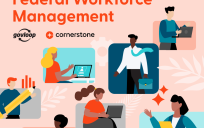The definition of insanity is doing the same thing over and over and expecting different results. To see better results, some inherent part of the process must change, but it’s hard for teams to think outside the box when no new people are involved. Habits die hard, so in looking to change the status quo, it’s important to have fresh brains tackle any deep-seated problem.
The U.S. Government Accountability Office (GAO) has identified one such deep-seated problem in the government – the skills gaps. Recently, the GAO published a report called “Federal Workforce: OPM and Agencies Need to Strengthen Efforts to Identify and Close Mission-Critical Skills Gaps.” Ron Sanders, Vice President of Booz Allen Hamilton, former Associate Director of National Intelligence and Chief Human Capital Officer, spoke with Christopher Dorobek for the show DorobekINSIDER on government skills gaps and how to mitigate the problem.
Where are the skills gaps located in government? According to Sanders, it depends on whom you’re asking. Many of the skills gaps are agency-specific, but these include banking regulators, economists, attorneys, scientists, and engineers, varying according to which agency you’re looking at. Agencies need to internally evaluate their own needs.
However, common to all agencies, for the most part, is cybersecurity. This seems like bad news, especially in light of all of the cybersecurity breaches in recent history. However, there is a great deal of room for improvement, because the government has a hiring advantage, as working in cybersecurity in government (rather than in the private sector) has its advantages.
“[Government cybersecurity] mission and brand have a competitive advantage. They do things that their commercial competitors can’t do,” said Sanders. “There are some inherently governmental things involving cybersecurity that are really cool, and the best and brightest want to go to those things.”
So, then, what’s holding the workers back?
According to Sanders, the government needs to reevaluate its hiring processes to be able to better compete with the private sector. Specifically, it needs to cut back on the unnecessary bureaucracy.
Financial incentives in the private sector are always substantial. However, another main reason that experts are steered away from government is because government-hiring processes are so weighed down and prolonged by the length of the process and the funding uncertainty.
“I would venture that it’s not all about compensation,” said Sanders. “It’s delays in hiring, delays in clearance, delays, delays, delays.” Often, due to these all of these timing setbacks, government agencies cannot make an offer to the applicants they want. The job seekers lean towards their definitive offers.
Bureaucracy strikes again in the sense that now that the government realizes the problem, it spends too much time and energy describing the extent of the problem, which detracts from acting to better the status quo. “We would be more competitive if we moved from counting to doing,” Sanders said. “Counting is fine, but we need to be exploring every policy and program option to actually compete once we know the gaps are there.”
What’s a better way of doing things, according to Sanders? Basically, prioritize. There are too many gaps in government skills to try to address them all. Agencies need to figure out where they are most keenly lacking, and take action to plug those holes first.
As always, it’s about diversity. There’s no way to be innovative without new talent. Routines are dangerous, especially in the government.





EXcellent article, Camilla. Kudos.